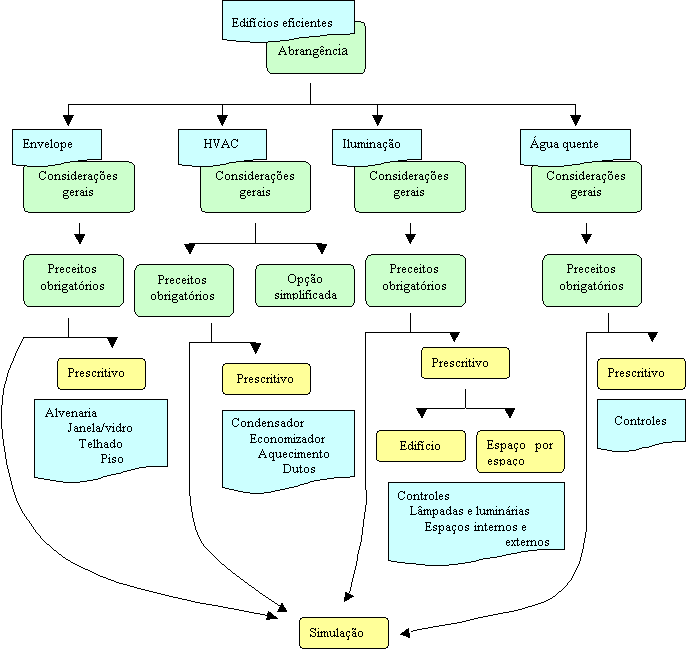Goal
The main objective of this project is to prepare a norm text to be submitted to the Municipality of Salvador establishing the energy efficiency standards to be adopted in new commercial buildings. This standard should establish minimum energy efficiency limits in lighting and air conditioning systems in commercial buildings, in addition to thermal performance limits for construction components, aiming to reduce electrical energy consumption in these buildings without compromising internal comfort levels. Such limits will be defined according to Salvador's climate. This standard must establish the minimum efficiency of engines, air conditioning equipment and water heaters to be used in new commercial buildings. An economic analysis of the limits to be adopted will be developed considering various tariff scenarios.
In addition to the main text of the standard, a manual to support the use of the norm must be developed.
As an integral part of the project, a survey of architectural typologies practiced in Salvador will be carried out. The analysis of the influence of construction parameters and project definitions must be carried out through computer simulation of prototypes defined from the construction typologies database, using hourly climate data for the city of Salvador, compiled in LabEEE in TRY format.
Justification
In Brazil, there is a diversity of end uses of electrical energy in the commercial sector, such as air conditioning, lighting, hot water, vertical transport, office equipment and water pumps. The lighting system consumes around 44% of the total consumption of a commercial building, with the air conditioning system consuming 20% (GELLER, 1990).
In response to the energy crisis in the country that required Brazil, in 2001, to have an energy rationing plan in four of its regions (GCE, 2001), decree No. 4,059, of December 19, 2001 regulated Law No. 10,295, of October 17, 2001, providing for the National Policy for Conservation and Rational Use of Energy by establishing the Management Committee for Energy Efficiency Indicators and Levels – CGIEE. This committee regulates the adoption of maximum energy consumption or minimum energy efficiency levels for each type of energy-consuming appliance and machine. The CGIEE should also set up the Technical Group for Energy Efficiency in Buildings in the Country in order to adopt “procedures for evaluating the energy efficiency of buildings”, propose technical reference indicators for energy consumption in efficient buildings and propose “technical requirements so that building projects to be built in the country meet the mentioned indicators”.
This is a global trend, already adopted in several countries. Standard 90.1 (ASHRAE, 1999) establishes limit conditions, as well as technical aspects of installation, the building envelope, properties of windows and doors, infiltration and tightness. In the air conditioning system, it establishes efficiency parameters based on system performance (COP). The lighting system is defined not only by its power per square meter, but also by the way the system is controlled, requiring additional controls for special lighting uses, such as task lighting.
Discussion
Standard 90.1 (ASHRAE, 1999) presents the limit conditions of the building envelope for Salvador depending on its climate. Indicates the design temperatures for applying the cooling strategies of 31o C for the dry bulb temperature and 26o C for the wet bulb temperature, also establishing the conditions limit according to the range of degrees day in which the base temperature is 10o C (Base temperature common to all locations registered in Standard 90.1, reason for being low for Salvador): 5001 -6000. It thus lists maximum transmittances and minimum insulation of opaque surfaces and maximum transmittances and maximum heat gain coefficients of natural lighting systems, such as windows or domes. The limit parameters established by Standard 90.1 (ASHRAE, 1999) do not consider, however, solar radiation or wind speed. The combined action of climatic factors such as radiation, wind and humidity are considered relevant for improving the recommendations of Standard 90.1 and will be considered in the simulations in the DOE 2.1-E program after surveying the construction typologies and building the computational model. The building components involved in electrical energy consumption will be defined in accordance with the conclusions of SIGNOR (1999) and the parameters defined in Standard 90.1 (ASHRAE, 1999). The installed power density of the lighting system, the INMETRO criteria for labeling according to the cooling capacity and its efficiency, are other factors to be included in the formulation of the standard for energy efficient buildings in Salvador.
Initial structure of the standard for Salvador

Bibliographic references
ASHRAE. Energy Standard for Buildings Except Low-Rise Residential Buildings. ASHRAE Standard 90.1 –1999. American Society of Heating, Refrigerating and Air-Conditioning Engineers, Inc. Atlanta, 1999.
GCE. The Electric Energy Crisis Management Chamber - GCE, determines that concessionaires, permit holders and authorized public electricity distribution services, in the Southeast, Center-West and Northeast Regions adopt the reduction of electricity supply to Consumer Units by they were met, starting electricity rationing. Resolution, no. 1, May 16, 2001. Lex: Official Gazette of the Union of May 17, 2001, Section 1, p. 1, vol. 139, n. 95 - E.
GELLER, H. S. Efficient electricity use: a development strategy for Brazil. Washinton D.C : American Council for an Energy-Efficient Economy, 1990.
SIGNOR, R. Análise de regressão do consumo de energia elétrica frente a variáveis arquitetônicas para edifícios comerciais climatizados em 14 capitais brasileiras. 1999, 122 p. Dissertação (Mestrado em Engenharia Civil) – Centro Tecnológico, Universidade Federal de Santa Catarina.